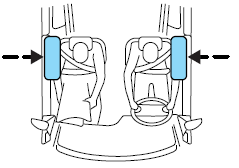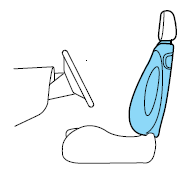Seat-mounted side airbag system

WARNING: Do not place objects or mount equipment on or near the airbag cover on the side of the seatbacks of the front seats or in front seat areas that may come into contact with a deploying airbag. Failure to follow these instructions may increase the risk of personal injury in the event of a collision.
WARNING: Do not use accessory seat covers. The use of accessory seat covers may prevent the deployment of the side airbags and increase the risk of injury in an accident.
WARNING: Do not lean your head on the door. The side airbag could injure you as it deploys from the side of the seatback.
WARNING: Do not attempt to service, repair, or modify the airbag SRS, its fuses or the seat cover on a seat containing an airbag. Contact your authorized dealer as soon as possible.
WARNING: All occupants of the vehicle should always wear their safety belts even when an airbag SRS is provided.
How does the side airbag system work?
The design and development of the side airbag system included recommended testing procedures that were developed by a group of automotive safety experts known as the Side Airbag Technical Working Group. These recommended testing procedures help reduce the risk of injuries related to the deployment of side airbags.

The side airbag system consists of the following:
Х An inflatable bag (airbag) with a
gas generator concealed behind
the outboard bolster of the driver
and front passenger seatbacks.
Х A special seat cover designed to
allow airbag deployment.
Х The same warning light,
electronic control and diagnostic
unit as used for the front airbags.
Х Two crash sensors mounted in the front doors (one on each side of
the vehicle).
Х Crash sensors located on the C pillars (one sensor on each pillar on
each side of the vehicle).
Side airbags, in combination with safety belts, can help reduce the risk of severe injuries in the event of a significant side impact collision.
The side airbags are fitted on the outboard side of the seatbacks of the front seats. In certain lateral collisions, the airbag on the side affected by the collision will be inflated. The airbag was designed to inflate between the door panel and occupant to further enhance the protection provided occupants in side impact collisions.
The airbag SRS is designed to activate when the vehicle sustains lateral deceleration sufficient to cause the sensors to close an electrical circuit that initiates airbag inflation.
The fact that the airbags did not inflate in a collision does not mean that something is wrong with the system. Rather, it means the forces were not of the type sufficient to cause activation. Side airbags are designed to inflate in side-impact collisions, not roll-over, rear-impact, frontal or near-frontal collisions, unless the collision causes sufficient lateral deceleration.
WARNING: Several air bag system components get hot after inflation. Do not touch them after inflation.

WARNING: If the side airbag has deployed, the airbag will not function again.
The side airbag system (including the seat) must be inspected and serviced by an authorized dealer. If the airbag is not replaced, the unrepaired area will increase the risk of injury in a collision.
See also:
Intelligent Oil Life Monitor
Your vehicle is equipped with an Intelligent Oil Life Monitor that
determines when the engine oil should be changed based on how your
vehicle is used. By using several important factors in its cal ...
Adding engine coolant
When adding coolant, make sure it is a 50/50 mixture of engine coolant
and distilled water. Add the mixture to the coolant reservoir, when the
engine is cool, until the appropriate fill level is o ...
How does the Personal Safety System work?
The Personal Safety System can adapt the deployment strategy of your
vehicleТs safety devices according to crash severity and occupant
conditions. A collection of crash and occupant sensors provid ...
